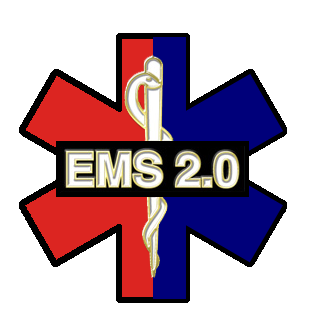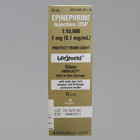One of the things that amazes me about this field is how tightly we hold on to our beliefs. It does not matter if it has to do with oxygen management or medication administration, or even C-Spine. People always seem to revert back to how they were taught the first time that they learned something presumably because it is uncomfortable. Maybe it is time to get comfortable with being uncomfortable. Make it is time to make change a way of life. It has been my experience that people seem to base a lot of decisions that they make off of one negative experience in their career over a more frequent positive one. We balk at giving pain medications to some patients because we believe that they are lying to us thanks to that one addict that we feel pulled a fast one on us in the early days in our career. Or we put the nitro aside on an inferior MI because this one time a medic that you met told you about a medic that they knew who dumped the pressure on a patient who then coded on them. The truth is though that the person in pain, regardless of their background, could benefit from that fentanyl, and chances are, that person having the MI will maintain their pressure and could greatly benefit from the treatment that you are so reluctant to give them. Or take response times as another example. Despite evidence to the contrary, and despite studies that have been conducted, there is little correlation between response times and mortality in a majority of the emergencies that we as EMS providers respond to. I happen to know of one rather large service that despite having an excellent ROSC rate they see a lower percentage of CPR saves in the more densely populated section of their service area with considerably lower response times than they do in the more suburban or rural areas. While the difference in miniscule, it is further proof that despite the fact that somebody gets on scene more quickly than in other areas, speed alone does not constitute more lives saved. I have always found the concept of...
Why Rhode Island is Getting It Right

Apr 24, 2017
As I said in last week’s article about Bob Harper, I am kind of playing catch up with a lot of topics, this being one of them. In late 2016, the State of Rhode Island announced publicly that on March 1 of this year, there would be a significant protocol change to their cardiac arrest protocols. Crews would be expected to remain on scene for 30 minutes prior to being transported. Topically, I applaud Rhode Island’s Department of Health for being as public and transparent as they were about this change. Anybody who has been in the field for even a modest amount of time has been on a scene where they were asked “why aren’t you just taking them to the hospital?” In some cases, there is some merit to that. In some cases there is very little that we as paramedics and EMTs can do for a patient on a scene. Cardiac arrest is not one of those emergencies. I saw some pushback online from some who consider themselves experts on the topic, but that’s neither here nor there. One common complaint that I saw revolved around scene safety. Obviously, scene safety trumps all. If I am coding someone in the middle of a street with an aggressive or growing crowd, I am going to think about moving. But on these calls are the exception to the rule, and on the vast majority of runs, even in the worst areas of someone’s coverage area, communication with families goes a long way. “We are doing everything for them right here that they would get in the emergency room. It is their best chance to survive.” That’s the common statement that I have made a number of times to families of patients in cardiac arrest. Maybe those dissenters failed to read the protocol, it states “Regardless of proximity to a receiving facility, absent concern for provider safety, or traumatic etiology for cardiac arrest, resuscitation should occur at the location the patient is found.” Emphasis is mine. Most of the write ups that I read from the online blogging community were written on or around the month of December. It is certainly possible that the...
Surviving Cardiac Arrest

Apr 21, 2017
I’ve been out of this writing game for a bit, so you are all going to have to forgive as I play catchup to some stories that might be just a little older. I assure you that they still carry relevance. In my time “away” from writing, I’ve been doing a lot with the Resuscitation Academy. Yes, that Resuscitation Academy. I teach its concepts, and some of my colleagues and I have completely drank the Kool-Aid. I will talk more about that at a later date, but I point it out here because I’ve become very passionate about all things cardiac arrest care which brings me to today’s story. Some of you might have read the story about Biggest Loser trainer Bob Harper who, while at Cross Fit in February, suffered a sudden cardiac arrest. In the article posted by CNN, Harper talks about how “. . . the fact there were doctors in the gym when I had the attack saved my life.” He talks about how the doctors did CPR on him, and the doctors pulled the AED off of the wall and used it on him. Mr. Harper is right, the almost immediate CPR and early defibrillation saved his life, there is absolutely no doubt about that, but the fact that the two people who provided care to him were doctors is completely irrelevant. It wasn’t two doctors who saved his life, it was two people who were willing to act instead of just waiting for someone else to do something. In this case, their occupation is not important. I do not want to diminish the heroics of this event but had the story could have been an incredibly powerful vessel had it been told a different way. The message that people need to hear in this case is that they need to learn CPR, some kind of CPR. They do not need an AHA card in their pocket but understanding the fundamentals of hands-only CPR, for example, a skill that can been learned in 15 minutes or less, is one that can save a life. Knowing where the AED’s are in the gym where you work out, or having the...
The Surfside Beach CPR Debacle
The first time I laid hands on a patient’s chest and did CPR, I was 16 years old. There were probably close to a dozen total times that I used the skill that I learned at the age of 14 before I was legally able to be the treating EMT by myself in the back of an ambulance, a responsibility that one must be 18 to hold. On the overwhelming majority of the CPR calls that I have been on in my career, let alone those two years before I was of legal age, I left the patient just like I found them, dead. On January 25, 2015, the Surfside Beach Fire Department in South Carolina rolled a rig with a CPR certified junior firefighter on the truck. At some point, it was that teenager’s turn to tag in on compressions and do their two minute duty. Much like nearly 93% of all cardiac arrests worked nationwide, that crew from the Surfside Beach Fire Department left the patient how they found them, dead, much to the dismay of the Surfside Beach town council. Almost a month ago, an “unnamed official” with the town filed a complaint, prompting an investigation by the State of South Carolina’s Department of Health and Environmental Control. The investigation, concluded earlier this week, found no evidence of wrong doing despite the shock and horror expressed by town officials. These are the kinds of stories that make the news that are related to our industry. No matter how futile the efforts might be, the loss of a patient is obviously catastrophic to a patient’s family, but blaming a teenager for performing a skill that is taught to kids as young as 10 is preposterous. Thankfully, there are many who agree with me on this stance. I got my start as a cadet on my first volunteer squad, and I had the chance to mentor a few other cadets over the years. It takes a special kind of person to handle the responsibilities that an EMT or first responder is tasked with at such a young age, but for every call, much like that junior firefighter in South Carolina, I was closely...
The Myth of Culture
Over the past couple of years I have read a few articles about the importance of living in the community that one serves. I have seen articles championing volunteer organizations because “people like being cared for by their neighbors” or implying that those who do care for their neighbors would do a better job because of their proximity both physically and emotionally to a patient. Other articles about fire based systems for example talk about how being part of a community can allow one to know the back roads and short cuts that might shave precious seconds off of response times thus saving countless lives. Further reading will reveal criticism of private EMS departments that come in from outside of the area and know little about the people that they are caring for. Some feel that not living in the area that one practices medicine in can result in them caring that much less about the people that they are providing medical care for. Based on some personal experiences that I have had, I fail to see any of these as being an absolute that one should lead an argument with. My first EMS position was in the town that I grew up in. Island Heights, New Jersey is small, populated by maybe 1,200 people during the summer months. It was impossible for me to go into a house on a call and not either know the patient or one of their relatives. From there I moved some 250 miles away for college, and spent the first twelve years of my career in Springfield, Massachusetts. I was a transplant, and as a white kid from suburbia, I did not fit the cultural makeup of the city that I worked in at all. Neither did the vast majority of my coworkers. Much like the majority of the workforce in EMS, we were Caucasian and majority male. Although I was not from the area I was able to learn the streets, and learn a lot about the culture as well. Working in Springfield pushed me to improve the quality of the Spanish that I spoke, and learn a little bit about the cultures that I was...
Testing Stinks
Years ago, when discussing the precepting program at my division, somebody said, “I don’t know why we are taking so much time to evaluate these people. They were able to pass the paramedic test that right there should tell us that they are ready for the field.” What this person did not understand is that testing that takes place in the written and practical settings have very little to do with. Our testing, which has evolved very little in the fifteen years that I have been a paramedic, has become so disconnected from what our profession actually does, and we need to start reevaluating it. Granted, my frame of reference is about three years old, and I am otherwise going by what I have heard third hand from people, but I can say, without a shadow of a doubt, that the practical stations that I went through in 2012 for my National Registry certification almost matched the stations I participated in back in 2000 when I received my certification in Massachusetts, the exception being the two oral stations that NREMT has added to the testing. I guess most of the credit for my performance in 2012 goes to the staff at Springfield College and the meticulous teaching of Gary Childs who was the head instructor back in 2000 who spent more than a year instilling on me the importance of things like memorizing the critical fail points of each station, ripping the tape before starting an IV, and making sure that I verbalize every single step as I do it in case an evaluator is not watching. I did, however, have to break a number of bad habits to get myself ready for the 2012 test. I found as I walked into each station that a number of steps that I was asked to do had little to do with how I perform as a paramedic. For example, as I freely walked around a patient and worked from all angles to apply the KED to the volunteer who was my patient, I could not help to think about not only how impractical this was, but I also wondered how many items I would have...
Video Clip: Bystander CPR

Apr 15, 2015
This weekend a number of friends on Facebook linked a video that was making the rounds of a person presumed to be in cardiac arrest in a car in front of a bus stop. This scene provides with a number of important lessons. First you see an SUV in the middle of the road with people yelling at the driver asking him if he is okay. 9-1-1 is called and somebody starts doing chest compressions on the person before removing him from the car and placing him in the road. CPR is continued until EMS arrives. At the end of the video you see the driver being wheeled to the ambulance sitting up appearing to be conscious on the stretcher. The video itself spans about seven minutes and I encourage everyone to take the time to watch the entire thing from beginning to end. Some content might be difficult to watch and there is some language that might be considered offensive used by those watching the scene unfold. Regardless of that though, there are a few lessons that I think both the EMS community and the general public can learn from this. http://medicsbk.com/wp-content/uploads/2015/04/Street-CPR.mp4 There are still people out there who are willing to help – In a world dominated by social media, Twitter and cell phones people seem to either want to record or just call for help and make a potential emergency somebody else’s problem. Seeing this video is reassurance that there are still people out there who will get their hands dirty to benefit another person. They saw somebody in distress and they acted. They realized that doing something is better than doing nothing. When you call 9-1-1 help is on the way almost immediately – Confusion is common. People misidentify locations in fact, I can tell you that happened here. Once a location is confirmed help is on the way but for dispatchers that is not where their job ends. If there is one place that a dispatcher’s role in providing prearrival instructions can save a life it is in the case of a patient in cardiac arrest. The bystanders can insist that the caller “just tell them to come!” until...
Ethics and Cardiac Arrest Management

Aug 15, 2014
Is potentially not saving one patient a worthwhile sacrifice if that loss helps pave the way for future saves? Is this ethical? These are two questions that Warwick University in England is having to tackle as they prepare to involuntarily enlist patients in a study to find out how effective epinephrine is in helping achieve ROSC and favorable long term outcomes. While long overdue, a study like this toes a fine line between what is ethical and the opportunity to answer a long debated question of whether or not epinephrine actually makes a difference in cardiac arrest. The results of this study could pave the way for some major changes in cardiac arrest management. The study will evaluate 8,000 out of hospital cardiac arrests with patient either receiving epinephrine or a placebo with outcomes evaluated after the arrest. The problem with studies on cardiac arrest is there will be a patient population that you just don’t get back and others where we achieve ROSC with very few interventions at all. In other words, sometimes even if you throw everything including the kitchen sink at a patient who arrests right in front of you, you still might not get them back. Still though, if things go as they hope they will, England could see an improvement on their dismal 6% out of hospital ROSC rate. I am sure that despite overwhelming support from the medical community in England, some will try and poke holes in the ethical aspect of this study. When any medic hears the words “CPR in progress” we immediately shift gears, and many of us will turn up the intensity and focus a notch or two. We know what the task at hand is. This is our bread and butter, it is what we are trained for. It is a true medical emergency. The prospect of possibly not doing everything we can for a patient in cardiac arrest is one that some will struggle with. When looking at the bigger picture though, with the right evidence the results of this study could be earth shaking. Personally though, I am happy that someone has finally built up enough guts to tackle this one....
BLS Defibrillation: Are We Doing Enough?

Jul 23, 2014
Recently, on the Resuscitation Facebook group, a discussion started regarding time on chest, time off chest, and the safety of defibrillation with active CPR being performed by a rescuer. While the core of the debate and the reasons behind why and why not one would voluntarily subject themselves to an electrical shock is one that really needs more research to validate, it became clear that reducing the peri-shock pause (the time with no CPR prior to and immediately after defibrillation) could actually make the concept of receiving said shock a non-factor. The discussion quickly turned to how long five seconds was, and how long three seconds was, and how with proper training and practice, a shock could almost be delivered on an upstroke with little to no pause in CPR. It goes without saying that time on chest is vital for cardiac arrest survival. Pit crew CPR teaches us some techniques to best deliver effective emergency responder CPR, but I feel like we can do better. What about the other lengthy hands off time in the pre-shock period? I am talking, of course, about the time that it takes an AED specifically to analyze the heart rhythm of a patient in cardiac arrest. Usual analyze time for a monitor in my experience has been around 5-7 seconds depending on the model. Once analysis is complete, many AED’s continue to announce “Stand Clear!” and start “spooling up” to their preset energy setting to prepare for a shock. When it comes to dealing with the general public, this is, in my opinion, appropriate. I do not expect some “Average Joe” who pulls an AED off a wall at the Mall of America to have the same ability to use it as someone who spent months (in some places a year) in an EMT class. Public AED’s are a great thing, but why are we not putting better training and maybe simple EKG recognition skills in the hands of our BLS providers? The first time I encountered an AED was in 1994. It was a big deal for our town. We had one for our two ambulance first aid squad and would switch it back and forth...
Let’s Train Them
CPR is increasingly becoming a requirement for high school graduation throughout the country, and personally I could not be happier. I love seeing news stories about this topic. When we are dispatched to a cardiac arrest in our system, one of the first questions I ask myself is “is anyone doing CPR?” I usually find that compressions are being done in about one out of every three “workable” cardiac arrests. More times than not, the thing most often preventing CPR being done is the fact that the caller has difficulty getting the patient from where they are to the floor. The second most frequent one is that the caller is too scared or just unwilling or unable to do it because they are too hysterical. I completely understand this. EMS professionals walk into these situations with training and the expectation that they will be there to bring order to the chaos. It is what we do. It is part of who we are and what our profession is all about. One cannot have that same expectation of the general public. Should a bystander be willing to do CPR, and they are untrained, they will get a crash course on the phone of how to do hands only CPR in the form of prearrival instructions from an Emergency Medical Dispatch certified person on the other end of the phone. It is virtually impossible to make sure that the person on the other end of the phone is following the instructions as they should. Of those one third that get compressions, probably half of them are done well. The plus side though is something is better than nothing when it comes to cardiac arrest care. Here we sit in 2014 with a generation of people (that arguably I am on the older side of being part of) who are consumed by their cell phones. People live in their phones, and use them to make potential medical emergencies someone else’s problem. Gone are the days of people moving away from these sorts of things. They call, and then they stand around to see what happens. Rarely do people get involved and try to help. We need to...
